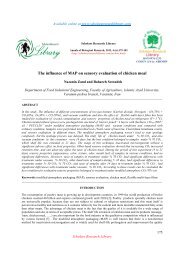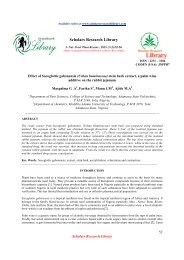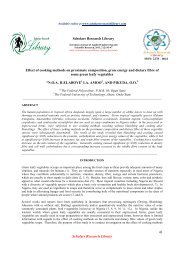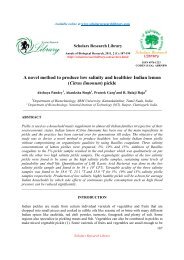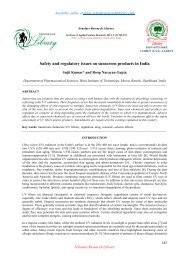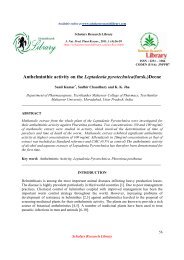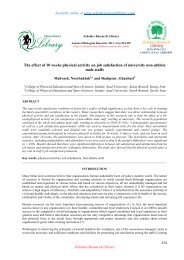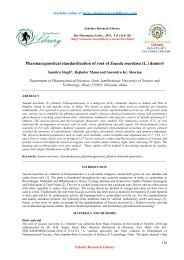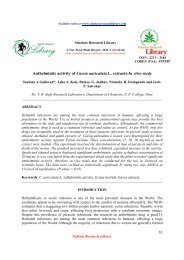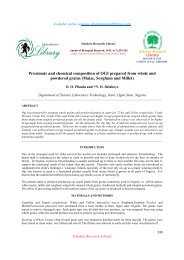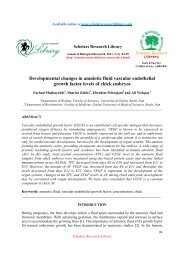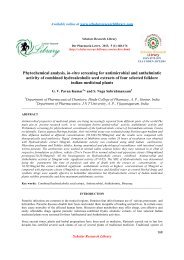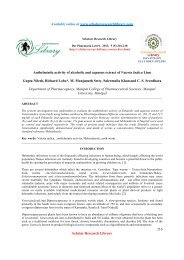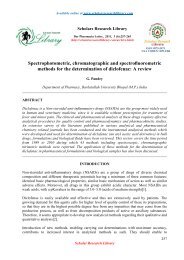Identification of wild medicinal plant in Dalahoo mountain - Scholars ...
Identification of wild medicinal plant in Dalahoo mountain - Scholars ...
Identification of wild medicinal plant in Dalahoo mountain - Scholars ...
You also want an ePaper? Increase the reach of your titles
YUMPU automatically turns print PDFs into web optimized ePapers that Google loves.
Available onl<strong>in</strong>e at<br />
www.scholarsresearchlibrary.com<br />
<strong>Scholars</strong> Research Library<br />
Annals <strong>of</strong> Biological Research, 2012, 3 (7):3234-3239<br />
(http://scholarsresearchlibrary.com/archive.html)<br />
ISSN 0976-1233<br />
CODEN (USA): ABRNBW<br />
<strong>Identification</strong> <strong>of</strong> <strong>wild</strong> <strong>medic<strong>in</strong>al</strong> <strong>plant</strong> <strong>in</strong> <strong>Dalahoo</strong> mounta<strong>in</strong> and their used<br />
<strong>in</strong>digenous knowledge (Kermanshah, Iran)<br />
Nasr<strong>in</strong> Eftekhar<strong>in</strong>asab 1 , Darush Zarei 2 , Safora Paidar 2 , Majid Jafari Moghadam 3 , Danial<br />
Kahrizi 4 , Masomeh Khanahmadi 1 and Piman Chenari 2<br />
1 Department <strong>of</strong> Chemistry, ACECR (Jahad-e-Daneshgahi), Kermanshah Unit, Iran<br />
2 Department <strong>of</strong> <strong>medic<strong>in</strong>al</strong> <strong>plant</strong>s (Jahad-e-Daneshgahi), Kermanshah, Iran<br />
3 Young Researchers Club, Mashhad Branch, Islamic Azad University Mashhad<br />
4 College <strong>of</strong> Agriculture, Razi University Kermanshah, Iran<br />
_____________________________________________________________________________________________<br />
ABSTRACT<br />
Iran is a country characterized by a wide range <strong>of</strong> climate and ecological conditions, possesses enormous diversity<br />
flora. In this research, 99 <strong>wild</strong> <strong>medic<strong>in</strong>al</strong> <strong>plant</strong> specimens were collected and identified. For gather<strong>in</strong>g <strong>in</strong>formation,<br />
we used local people, especially older adult; <strong>in</strong> addition, we used field survey methods and library researches. The<br />
results showed that the most species belonged to Compositae and Umbelifera families with 15 and 7 species,<br />
respectively. The <strong>medic<strong>in</strong>al</strong> <strong>plant</strong>s which were collected belonged to 46 different <strong>plant</strong> families. Leaves and flowers<br />
are mostly used compare to roots and stems. Common dosage form <strong>of</strong> these herbal medic<strong>in</strong>es is <strong>in</strong>fusion and<br />
o<strong>in</strong>tment. These herbal medic<strong>in</strong>es are mostly used to treat chronic gastro<strong>in</strong>test<strong>in</strong>al diseases and sk<strong>in</strong> disorders.<br />
Local <strong>in</strong>habitants also use these <strong>wild</strong> <strong>medic<strong>in</strong>al</strong> <strong>plant</strong>s as spice and flavors for different foods and dairy products.<br />
Some <strong>of</strong> the newest <strong>medic<strong>in</strong>al</strong> medications are made based on <strong>in</strong>digenous knowledge. Such scientific studies for<br />
<strong>in</strong>troduc<strong>in</strong>g a region flora can be beneficial f<strong>in</strong>ancially for local people as well; for example, more tourists may visit<br />
this area. Vegetation <strong>in</strong>vestigation <strong>of</strong> a region helps us to get more <strong>in</strong>formation about abundant and scarce species<br />
and f<strong>in</strong>d a way to ma<strong>in</strong>ta<strong>in</strong> rangelands and germplasm.<br />
Keywords: Wild <strong>medic<strong>in</strong>al</strong> <strong>plant</strong>, <strong>Dalahoo</strong> Mounta<strong>in</strong>, Indigenous knowledge, Germplasm, Herbal medic<strong>in</strong>es<br />
_____________________________________________________________________________________________<br />
INTRODUCTION<br />
Medic<strong>in</strong>al <strong>plant</strong>s represent an important health and economic component <strong>of</strong> biodiversity. So, it is essential to make<br />
complete <strong>in</strong>ventory <strong>of</strong> the <strong>medic<strong>in</strong>al</strong> component <strong>of</strong> the flora <strong>of</strong> any country for conservation and susta<strong>in</strong>able use [1].<br />
These <strong>plant</strong>s play an essential role <strong>in</strong> traditional health care, about 80% <strong>of</strong> the world’s <strong>in</strong>habitants rely<strong>in</strong>g ma<strong>in</strong>ly on<br />
traditional medic<strong>in</strong>es for their primary health care [2]. Natural sources such as mounta<strong>in</strong>s and rangelands have been<br />
the source <strong>of</strong> <strong>medic<strong>in</strong>al</strong> agents for thousands <strong>of</strong> years, and some important modern drugs have been derived from<br />
natural sources, many based on their use <strong>in</strong> traditional medic<strong>in</strong>e [3]. In human history, people used various materials<br />
from nature to cure their illnesses and improved their health [3]. Popular knowledge <strong>of</strong> <strong>plant</strong>s used by humans is<br />
based on thousands <strong>of</strong> years <strong>of</strong> experience. By “trial and error”, people learnt how to recognize and use <strong>plant</strong>s,<br />
<strong>in</strong>clud<strong>in</strong>g those with magic-religious function [4]. Iranians have been us<strong>in</strong>g herbal medic<strong>in</strong>e for the treatment <strong>of</strong><br />
some daily diseases [1], so lots <strong>of</strong> studies have been done for <strong>in</strong>troduc<strong>in</strong>g <strong>wild</strong> <strong>medic<strong>in</strong>al</strong> <strong>plant</strong>s <strong>in</strong> different parts <strong>of</strong><br />
Iran. For example, Ahmadi [5], gathered and identified 96 species <strong>of</strong> <strong>medic<strong>in</strong>al</strong> <strong>plant</strong>s <strong>in</strong> Lorestan and showed that<br />
most <strong>of</strong> them belong to the families <strong>of</strong> Liliaceae, Asteraceae, Lam<strong>in</strong>aceae, and Rosaceae. Mazandarani et al. [6],<br />
<strong>in</strong>troduced 107 <strong>medic<strong>in</strong>al</strong> <strong>plant</strong>s from the mounta<strong>in</strong> <strong>of</strong> Ziarat <strong>in</strong> Gorgan belong<strong>in</strong>g to 103 genera and 42 families.<br />
Zarezadeh et al. [7], studied 37 species <strong>of</strong> drought resistant <strong>medic<strong>in</strong>al</strong> <strong>plant</strong>s <strong>in</strong> Yazd and found out that the families<br />
<strong>Scholars</strong> Research Library<br />
3234
N Eftekhar<strong>in</strong>asab et al Annals <strong>of</strong> Biological Research, 2012, 3 (7):3234-3239<br />
_____________________________________________________________________________<br />
Apiaceae, Lam<strong>in</strong>aceae, and Solanaceae had the most number <strong>of</strong> species. Akbar<strong>in</strong>ia et al. [8], studied the <strong>medic<strong>in</strong>al</strong><br />
<strong>plant</strong>s <strong>in</strong> Ghazv<strong>in</strong> with regard to their biological and floristic features. They identified 85 <strong>medic<strong>in</strong>al</strong> species<br />
belong<strong>in</strong>g to 33 classes and 76 genera, with the classes Lam<strong>in</strong>aceae with 21 and Asteraceae with 6 species be<strong>in</strong>g the<br />
most important classes. Vahedi and Yasari [9], identified the <strong>medic<strong>in</strong>al</strong> <strong>plant</strong>s at the mounta<strong>in</strong>ous rangelands <strong>of</strong><br />
Lasem <strong>in</strong> Larijan <strong>of</strong> northern Iran, The results showed that there were 42 <strong>medic<strong>in</strong>al</strong> species <strong>in</strong> the area belong<strong>in</strong>g to<br />
18 classes. The classes Rosaceae with 8, Compositae with 8, and Labiateae with 7 species had the biggest number <strong>of</strong><br />
<strong>medic<strong>in</strong>al</strong> species. In other parts <strong>of</strong> the world, the same studies have been done as well. For example. Y<strong>in</strong>ger et al.<br />
[10], studied the <strong>medic<strong>in</strong>al</strong> <strong>plant</strong>s at Bale Mounta<strong>in</strong>s National Park <strong>in</strong> Ethiopia and they identified 74 species<br />
belong<strong>in</strong>g to 64 genera and 27 families <strong>of</strong> <strong>medic<strong>in</strong>al</strong> <strong>plant</strong>s. Abbasi et al. [11], studied 54 ehnomedicic<strong>in</strong>al <strong>plant</strong><br />
species <strong>in</strong> Abbottabad district, North West Frontier, Pakistan, belong<strong>in</strong>g to 40 families distributed <strong>in</strong> 51genera have<br />
been recorded and the most dom<strong>in</strong>ant families <strong>in</strong> the study are Lamiaceae and Asteraceae. Bora et al. [12], identified<br />
23 species which belong to 15 families. Accord<strong>in</strong>g to their research, stem, leaf, rhizome, and root were mostly used<br />
respectively Shahrokhi, [13] showed that local knowledge <strong>of</strong> <strong>medic<strong>in</strong>al</strong> <strong>plant</strong>s is an effective factor for susta<strong>in</strong>able<br />
development, and mentioned the protection <strong>of</strong> the environment, the production <strong>of</strong> raw materials, the creation <strong>of</strong> jobs<br />
and the access to the <strong>in</strong>ternational market. Even though the traditional medical practitioners are the best sources <strong>of</strong><br />
<strong>in</strong>formation about the knowledge <strong>of</strong> the <strong>medic<strong>in</strong>al</strong> <strong>plant</strong>s, it is very difficult to obta<strong>in</strong> their traditional <strong>medic<strong>in</strong>al</strong><br />
<strong>in</strong>formation as they thought <strong>of</strong> their <strong>in</strong>digenous knowledge as a pr<strong>of</strong>essional secret [14]. Hence, the present study<br />
was <strong>in</strong>itiated to <strong>in</strong>vestigate the <strong>wild</strong> <strong>medic<strong>in</strong>al</strong> <strong>plant</strong>s and traditional knowledge <strong>in</strong> <strong>Dalahoo</strong> mounta<strong>in</strong>, Western<br />
Kermanshah<br />
MATERIALS AND METHODS<br />
1. Study region<br />
The study was carried out from March 2009 to November <strong>in</strong> <strong>Dalahoo</strong> mounta<strong>in</strong>ous region, West <strong>of</strong> the city <strong>of</strong><br />
Kermanshah <strong>in</strong> IRAN (fig 1). Climatology data dur<strong>in</strong>g growth period is characterized <strong>in</strong> table 1. This region has a<br />
longitude <strong>of</strong> 45º 53’ to 46º 50’and latitude <strong>of</strong> 34º 40’ to 34º90’, an area <strong>of</strong> 1930 Km, and its altitude varies from<br />
1500 to 2100 meters above sea level. The average yearly temperature is 13.7 degrees centigrade and the average<br />
yearly ra<strong>in</strong>fall is 528 millimeters. The climate <strong>of</strong> the area varies from semi-humid at low parts.<br />
Fig1. Study region<br />
2. Methodology<br />
Plants were collected from the studied area Fig 1. The collected <strong>plant</strong> taxa were dried accord<strong>in</strong>g to herbarium<br />
techniques, and numbered then recorded. The Flora <strong>of</strong> Iranica and the other flora and references (parsa – Persian)<br />
were used for the identification <strong>of</strong> the specimens. The ethno<strong>medic<strong>in</strong>al</strong> <strong>in</strong>ventory is presented by <strong>plant</strong> name, family<br />
and used parts. The Diagram <strong>of</strong> abundance was designed by EXCEL. Interviews were done, especially with older<br />
adults, traditional medical practitioners, herbal product sellers and farmers.<br />
<strong>Scholars</strong> Research Library<br />
3235
N Eftekhar<strong>in</strong>asab et al Annals <strong>of</strong> Biological Research, 2012, 3 (7):3234-3239<br />
_____________________________________________________________________________<br />
Climatology<br />
factors<br />
January<br />
February<br />
March<br />
April<br />
May<br />
June<br />
July<br />
August<br />
September<br />
October<br />
November<br />
December<br />
Table1: Climatology data dur<strong>in</strong>g growth period <strong>of</strong> <strong>wild</strong> <strong>medic<strong>in</strong>al</strong> <strong>plant</strong>s <strong>Dalahoo</strong> region (2009)<br />
M<strong>in</strong>imum<br />
temperature(°C)<br />
-1.7<br />
-4.7<br />
0.8<br />
4.7<br />
9.4<br />
15.1<br />
18.6<br />
21.0<br />
17.4<br />
13.2<br />
7.4<br />
2.3<br />
Maximum<br />
temperature(°C<br />
8.4<br />
5.7<br />
12.5<br />
16.7<br />
21.8<br />
31.7<br />
34.7<br />
36.0<br />
34.1<br />
27.7<br />
20.6<br />
15.6<br />
Average<br />
temperature(°C)<br />
3.4<br />
0.5<br />
6.6<br />
10.7<br />
15.6<br />
23.4<br />
26.6<br />
28.5<br />
25.8<br />
20.5<br />
14.0<br />
9.0<br />
RESULTS AND DISCUSSION<br />
<strong>Scholars</strong> Research Library<br />
Relative humidity<br />
(%)<br />
84<br />
91<br />
78<br />
80<br />
80<br />
50<br />
46<br />
34<br />
37<br />
52<br />
57<br />
65<br />
Average ra<strong>in</strong>fall<br />
(mm)<br />
36.6<br />
132.8<br />
110.6<br />
80.7<br />
131.6<br />
0.6<br />
0<br />
1.2<br />
0<br />
4.4<br />
64.4<br />
52<br />
We collected and identified 99 speceis. The most dom<strong>in</strong>ant families <strong>in</strong> the study are Compositae ( 15 species)<br />
Umbelifera ( 7 species) Legum<strong>in</strong>osae (6 species) Liliaceae (6 species) Rosaceae (5 species) Gram<strong>in</strong>ae (5 species)<br />
Labiatae (5 species) Solanaceae (4species) Polygonaceae (4 species) Papaveraceae (3 species), Plantag<strong>in</strong>aceae<br />
Anacardiaceae Cruciferae (2 species each) and rema<strong>in</strong><strong>in</strong>g families with one species each fig 2 and table 2. For each<br />
species, scientific name, family, used parts are provided <strong>in</strong> table 2. The questionnaires were used for documentation<br />
<strong>of</strong> flok <strong>in</strong>digenous knowledge. The most <strong>of</strong> herbal medic<strong>in</strong>es are made by leaves and flowers. They are <strong>in</strong> the form<br />
<strong>of</strong> <strong>in</strong>fusion and o<strong>in</strong>tment. These herbal medic<strong>in</strong>es are mostly used to treat chronic gastro<strong>in</strong>test<strong>in</strong>al diseases and sk<strong>in</strong><br />
disorders. Oak, liquorice, prickly artichoke and yarrow are commonly used for chronic stomach diseases. Local<br />
<strong>in</strong>habitants use these <strong>medic<strong>in</strong>al</strong> <strong>plant</strong>s for different purposes. Some common <strong>in</strong>dications one mentioned <strong>in</strong> table 3.<br />
Fig 2. Abundance <strong>of</strong> <strong>medic<strong>in</strong>al</strong> <strong>plant</strong> families <strong>in</strong> the region<br />
3236
N Eftekhar<strong>in</strong>asab et al Annals <strong>of</strong> Biological Research, 2012, 3 (7):3234-3239<br />
_____________________________________________________________________________<br />
Number<br />
1<br />
2<br />
3<br />
4<br />
5<br />
6<br />
7<br />
8<br />
9<br />
10<br />
11<br />
12<br />
13<br />
14<br />
15<br />
16<br />
17<br />
18<br />
19<br />
20<br />
21<br />
22<br />
23<br />
24<br />
25<br />
26<br />
27<br />
28<br />
29<br />
30<br />
31<br />
32<br />
33<br />
34<br />
35<br />
36<br />
37<br />
38<br />
39<br />
40<br />
41<br />
42<br />
43<br />
44<br />
45<br />
46<br />
47<br />
48<br />
49<br />
50<br />
51<br />
52<br />
53<br />
54<br />
55<br />
56<br />
57<br />
58<br />
59<br />
60<br />
61<br />
62<br />
63<br />
64<br />
65<br />
66<br />
67<br />
68<br />
69<br />
Table2. List <strong>of</strong> <strong>medic<strong>in</strong>al</strong> <strong>plant</strong>, scientific name, family name, Lat<strong>in</strong> name, parts used<br />
Scientific name<br />
Eremurus spectabiils<br />
Allium sativum L.<br />
Allium latifolium<br />
Allium hirtifolium Boiss<br />
Allium kharputense<br />
Fritillaria imperialis<br />
Aster amellus<br />
Ageratum conyzoides<br />
Cnicus benedictus<br />
Achillea spp<br />
Anthemis spp<br />
Arctium lappa L.<br />
Acroptilon repens<br />
Tragopogon orientalis<br />
Ech<strong>in</strong>ops cephalotes DC<br />
Artemisia hausskenechtii<br />
Gundelia tournefortii L.<br />
Cichorium <strong>in</strong>tybus<br />
Bellis perennis<br />
Arnica montana<br />
Carthamus lanatus L<br />
Trigonella foenum-graecum<br />
Astragalus tragacantha.spp<br />
Astragalus gossyp<strong>in</strong>us fisch<br />
Lens esculenta<br />
Glycyrrhiza glabra L.<br />
Rosmar<strong>in</strong>us <strong>of</strong>fic<strong>in</strong>alis L<br />
Foeniculum volgar<br />
Ferulago angulate Boiss<br />
Falcaria vulgaris<br />
Aethusa cynapium<br />
Apium graveole<br />
Dorema aucheri Boiss<br />
Heracleum persicum<br />
Datura stramarium<br />
Hyoscyamus kotschianus pojark<br />
Atropa beladona<br />
Solanum nigrum<br />
Rubus idaeus<br />
Amygdalus communisl<br />
Rosa can<strong>in</strong>a<br />
Rosa foetida herman<br />
Crataegus spp<br />
Cyhodon dactylon<br />
Alopecurus agrestis<br />
Phrogmites communis<br />
Arrhenatherum avenaceum<br />
Avena sativa<br />
Zataria multiflora Boiss<br />
Thymus vulgaris L<br />
Satureja edmundi<br />
Mentha langifolia<br />
Salvia bracteata<br />
Chelidonium majus<br />
Papaver spp<br />
Papaver somniferum<br />
Rumex conglomeratus<br />
Rumex spp<br />
Rheum ribes L.<br />
Polygonum aviculare L.<br />
Plantago major<br />
Plantago lanceolata<br />
Rhus coriaria<br />
Pistacia atlantica desef<br />
Anastatica hierochantica<br />
Nasturtium <strong>of</strong>fic<strong>in</strong>ale<br />
Nerium oleander L.<br />
Quercus brantii<br />
Aesculus hippocastanum<br />
Family name<br />
Liliaceae<br />
Liliaceae<br />
Liliaceae<br />
Liliaceae<br />
Liliaceae<br />
Liliaceae<br />
Compositae<br />
Compositae<br />
Compositae<br />
Compositae<br />
Compositae<br />
Compositae<br />
Compositae<br />
Compositae<br />
Compositae<br />
Compositae<br />
Compositae<br />
Compositae<br />
Compositae<br />
Compositae<br />
Compositae<br />
Legum<strong>in</strong>osae<br />
Legum<strong>in</strong>osae<br />
Legum<strong>in</strong>osae<br />
Legum<strong>in</strong>osae<br />
Legum<strong>in</strong>osae<br />
Legum<strong>in</strong>osae<br />
Umbelliferae<br />
Umbelliferae<br />
Umbelliferae<br />
Umbelliferae<br />
Umbelliferae<br />
Umbelliferae<br />
Umbelliferae<br />
Solanaceae<br />
Solanaceae<br />
Solanaceae<br />
Solanaceae<br />
Rosaceae<br />
Rosaceae<br />
Rosaceae<br />
Rosaceae<br />
Rosaceae<br />
Gram<strong>in</strong>ae<br />
Gram<strong>in</strong>ae<br />
Gram<strong>in</strong>ae<br />
Gram<strong>in</strong>ae<br />
Gram<strong>in</strong>ae<br />
Labiatae<br />
Labiatae<br />
Labiatae<br />
Labiatae<br />
Labiatae<br />
Papaveraceae<br />
Papaveraceae<br />
Papaveraceae<br />
Polygonaceae<br />
Polygonaceae<br />
Polygonaceae<br />
Polygonaceae<br />
Plantag<strong>in</strong>aceae<br />
Plantag<strong>in</strong>aceae<br />
Anacardiaceae<br />
Anacardiaceae<br />
Cruciferae<br />
Cruciferae<br />
Apocynaceae<br />
Fagaceae<br />
Hippocastanaceae<br />
<strong>Scholars</strong> Research Library<br />
Lat<strong>in</strong> name<br />
Asphodel<br />
Garlic<br />
Wild leek<br />
Shallot<br />
-<br />
Crown imperial<br />
Starwort<br />
Bastard agrimony<br />
Blessed thistle<br />
Yarrow<br />
Wild chamomile<br />
Burdock<br />
Rye grass<br />
Yellow goat’s beard<br />
Globe thistle<br />
Sagebrush<br />
Prickly artichoke<br />
Succory<br />
Daisy<br />
Mounta<strong>in</strong> tobacco<br />
Woolly safflower<br />
Fenugreek<br />
Milkvetch<br />
Milkvetch<br />
Lentil<br />
Liquorice<br />
Rosemary<br />
Fenel<br />
Chervil<br />
Goose foot<br />
Lesser hemlock<br />
Wild Celery<br />
-<br />
Persian marjoram<br />
Jimson weed<br />
Henbane<br />
Rag<strong>in</strong>g nightshade<br />
Woody nightshade<br />
Raspberry<br />
Bitter almond<br />
Rose<br />
Yellow canker flower<br />
Hawthorn<br />
Bermuda grass<br />
Bottle grass<br />
Common reed<br />
False oat grass<br />
Oat<br />
Thyme<br />
Garden thyme<br />
Thyme<br />
Pennyroyal<br />
Sage<br />
Celand<strong>in</strong>e<br />
Corn poppy<br />
Opium poppy<br />
Wood sorrel<br />
Wood sorrel<br />
Rhubarb<br />
Knowt-grass<br />
Way bread<br />
W<strong>in</strong>dles<br />
Sumach<br />
Persian turpent<strong>in</strong>e tree<br />
Rose <strong>of</strong> jericho<br />
Watercresse<br />
Oleander<br />
Oak<br />
Horse chestnut<br />
Parts Used<br />
Root<br />
Bulb<br />
All shoot<br />
Bulb<br />
Bulb<br />
Root, flower<br />
Flower<br />
Flower<br />
Seed, flower, leaf<br />
All shoot<br />
Flower<br />
Fruit, leaf<br />
Flower branch<br />
All shoot<br />
Seed, fruit<br />
Flower branch<br />
Root, seed<br />
Root, leaf<br />
Flower,leaf<br />
Stem, leaf<br />
Flower<br />
Seed<br />
Black gum<br />
White gum<br />
Seed<br />
Root<br />
Fruit<br />
Seed<br />
All shoot<br />
Fresh leaf<br />
Seed , All shoot<br />
Leaf<br />
Flower<br />
Flower branch<br />
Leaf<br />
Seed<br />
Fruit<br />
Seed<br />
Fruit, leaf<br />
Fruit<br />
Flower<br />
Flower<br />
Fruit<br />
Root<br />
Seed<br />
Root<br />
Seed, stem<br />
Seed<br />
All shoot<br />
All shoot<br />
All shoot<br />
All shoot<br />
All shoot<br />
All shoot<br />
Flower, capsule<br />
Capsule<br />
Fruit<br />
Seed,fruit<br />
Flower, latex<br />
Stem,leaf<br />
Leaf, flower<br />
Leaf, flower<br />
Fruit<br />
Gum,fruit<br />
-<br />
Fresh root and leaf<br />
Leaf<br />
Fruit<br />
Fruit<br />
3237
N Eftekhar<strong>in</strong>asab et al Annals <strong>of</strong> Biological Research, 2012, 3 (7):3234-3239<br />
_____________________________________________________________________________<br />
70<br />
71<br />
72<br />
73<br />
74<br />
75<br />
76<br />
77<br />
78<br />
79<br />
80<br />
81<br />
82<br />
83<br />
84<br />
85<br />
86<br />
87<br />
88<br />
89<br />
90<br />
91<br />
92<br />
93<br />
94<br />
95<br />
96<br />
97<br />
98<br />
99<br />
Number<br />
1<br />
2<br />
3<br />
4<br />
5<br />
6<br />
7<br />
8<br />
9<br />
10<br />
11<br />
12<br />
13<br />
14<br />
15<br />
16<br />
17<br />
18<br />
19<br />
20<br />
21<br />
22<br />
23<br />
24<br />
25<br />
Rubia t<strong>in</strong>ctorium<br />
Ruta graveolens<br />
Typha angustifolia<br />
Viola odoratal L.<br />
Hippophae rhamnoides<br />
Sesamum <strong>in</strong>dicum L.<br />
Crocus haussknechtii Boiss<br />
Alhagi persarum Boiss & Buhse<br />
Abies nigra<br />
Althea <strong>of</strong>fic<strong>in</strong>alis<br />
Borago <strong>of</strong>fic<strong>in</strong>alis<br />
Cyclamen <strong>of</strong>fic<strong>in</strong>ale<br />
Citrullus colocynthis<br />
Ficus carica<br />
Fumaria volgar loisel<br />
Verbana <strong>of</strong>fic<strong>in</strong>alis.L<br />
Cannabis sativa<br />
Anemone coronaria<br />
Plumbago europaea L.<br />
Peganum harmala L.<br />
Aristolochia botta<br />
Adianthum capillus- vernis<br />
Dactylorhiza umbrosa<br />
Paliurus sp<strong>in</strong>a<br />
Scrophularia striata<br />
Ephedra <strong>in</strong>termedia schr<br />
Euphorbia helioscopis<br />
Agaricus aurantiacus<br />
Convolvulus arvensis<br />
Reseda.spp<br />
Table 3: Herbal medic<strong>in</strong>es used by <strong>Dalahoo</strong> mounta<strong>in</strong> <strong>in</strong>habitants<br />
Scientific name<br />
Astragalus tragacantha.spp<br />
Astragalus gossyp<strong>in</strong>us fisch<br />
Foeniculum volgar<br />
Ferulago angulate Boiss<br />
Quercus brantii<br />
Rosa can<strong>in</strong>a<br />
Rosa foetida herman<br />
Reseda.spp<br />
Glycyrrhiza glabra L.<br />
Dactylorhiza umbrosa<br />
Cannabis sativa<br />
Borago <strong>of</strong>fic<strong>in</strong>alis<br />
Rubus idaeus<br />
Allium sativum L.<br />
Achillea spp<br />
Arnica montana<br />
Trigonella foenum-graecum<br />
Carthamus lanatus L<br />
Falcaria vulgaris<br />
Dorema aucheri Boiss<br />
Mentha langifolia<br />
Papaver somniferum<br />
Pistacia atlantica desef<br />
Hippophae rhamnoides<br />
Satureja edmundi<br />
Rubiaceae<br />
Rutaceae<br />
Typhaceae<br />
Violaceae<br />
Elaegnaceae<br />
Pedaliaceae<br />
Iridaceae<br />
Pappilonaceae<br />
Coniferae<br />
Malvaceae<br />
Borag<strong>in</strong>aceae<br />
Primulaceae<br />
Cucurbitaceae<br />
Moraceae<br />
Fumariaceae<br />
Verbanceae<br />
Cannab<strong>in</strong>aceae<br />
Ranunculaceae<br />
Plumbag<strong>in</strong>aceae<br />
Zygophyllaceae<br />
Aristolochiaceae<br />
Polypodiaceae<br />
Orchidaceae<br />
Rhamnaceae<br />
Scrophulariaceae<br />
Ephedraceae<br />
Ephorbiaceae<br />
Agaricaceae<br />
Convolvulaceae<br />
Resedaceae<br />
Usage<br />
Stomach and chronic gastro<strong>in</strong>test<strong>in</strong>al diseases , asthma<br />
Anti fungi, sk<strong>in</strong> diseases, hair gel<br />
Bellyache, flu, emphysema<br />
Flavored butter<br />
Animal feed, stomach ulcers, charcoal<br />
Home made alcoholic beverages, flavored tea<br />
Kidney stone and kidney <strong>in</strong>fection<br />
Spice for food and bread<br />
Stomach ulcers (roots)<br />
Icecream and desert<br />
Ecstasiz<strong>in</strong>g, halluc<strong>in</strong>ation<br />
Sedative<br />
Juice and jam<br />
Insect Repellents, Rheumatism<br />
Chronic gastro<strong>in</strong>test<strong>in</strong>al diseases<br />
Dis<strong>in</strong>fectant (poultry)<br />
Bellyache, flu, emphysema<br />
Color(food)<br />
Peptic ulcers (dry leaves <strong>in</strong> yoghurt)<br />
Pa<strong>in</strong> relief, sedative, toothache<br />
Carm<strong>in</strong>ative, spice (foods and tea)<br />
Insects st<strong>in</strong>g (latex)<br />
Peptic ulcers, moisturizer(ceram), spice( yoghurt, jam and souse)<br />
Aromatiz<strong>in</strong>g<br />
Carm<strong>in</strong>ative, spice (food and tea)<br />
CONCLUSION<br />
<strong>Dalahoo</strong> mounta<strong>in</strong> has a rich <strong>plant</strong> diversity. Accord<strong>in</strong>g to our research and observations, local people <strong>in</strong> this region<br />
have used these <strong>medic<strong>in</strong>al</strong> <strong>plant</strong>s for a long time. However, these products can be found as food additives <strong>in</strong> modern<br />
kitchens <strong>in</strong> the big cities. Aalthough these <strong>medic<strong>in</strong>al</strong> <strong>plant</strong>s are mostly considered as food additives, they have useful<br />
<strong>medic<strong>in</strong>al</strong> properties as well.Some species such as crown imperial, thyme, woody nightshade and opium poppy have<br />
been used more frequently by people; as a result, such species are scarce <strong>in</strong> this area. On the other hand, some<br />
species such as yarrow, liquorice, oak, woolly safflower and <strong>wild</strong> chamomile are abundant <strong>in</strong> this region.<br />
<strong>Scholars</strong> Research Library<br />
Madder<br />
Rue<br />
Cat’s tail<br />
Sweet-violet<br />
Seabackthorn<br />
Sesame<br />
Saffron<br />
Camel thorn<br />
Black fir<br />
Marshmallow<br />
Borage<br />
Cyclamen<br />
Bitter apple<br />
Figtree<br />
Fumitory<br />
Holy-herb<br />
Hemp<br />
Poppy anemone<br />
Leadwort<br />
Harmel<br />
Birthwort<br />
Maidenhair<br />
Orchid<br />
Garland thorn<br />
-<br />
Meadow sweet<br />
Spurg<br />
Larch<br />
Field b<strong>in</strong>dweed<br />
Weld<br />
Leaf, root<br />
Flower,leaf, stem<br />
Fruit<br />
Flower,leaf<br />
Leaf,fruit<br />
Seed<br />
Tubercule<br />
Flower branch<br />
Leaf<br />
Flower<br />
Flower<br />
Flower<br />
Fruit<br />
Fruit<br />
All shoot<br />
All shoot<br />
Seed<br />
Flower<br />
Root<br />
Seed, fruit<br />
Fruit ,seed<br />
All shoot<br />
All shoot<br />
Ash<br />
All shoot<br />
Leaf, stem<br />
All shoot<br />
Flower<br />
Seed<br />
3238
N Eftekhar<strong>in</strong>asab et al Annals <strong>of</strong> Biological Research, 2012, 3 (7):3234-3239<br />
_____________________________________________________________________________<br />
Such studies help us to identify endanger species; for example, thyme seeds and roots are given by the government<br />
to farmers <strong>in</strong> order to conserve <strong>wild</strong> thyme.<br />
REFERENCES<br />
[1]. N.A. Seighali and S. Zaker , Advances <strong>in</strong> Bioresearch, 2010, 1(1). 110-122<br />
[2].World Health Organization. 2002-2005, Geneva.<br />
http://www.who.<strong>in</strong>t/medic<strong>in</strong>es/library/trm/trm_strat_eng.pdf<br />
[3]. A.Ghorbani, F. Naghibi, M. Mosaddegh. Iranian Journal <strong>of</strong> Pharmaceutical Sciences, 2006, 2(2):109-118<br />
[4]. J.L.Camejo-Rodrigues, M.À.Ascensao, Bonet, J.Valles. Journal <strong>of</strong> Ethnopharmacology, 2003, 89, 199–209<br />
[5]. S.Ahmadi , Summary <strong>of</strong> reports on research projects, The Organization <strong>of</strong> Agricultural Research and Tra<strong>in</strong><strong>in</strong>g,<br />
Tehran, Iran 2003, p. 683.<br />
[6]. M .Mazandarani, M .Kassaee. Medic<strong>in</strong>al Plants Research Quarterly, 2004, 20(1):39-58.<br />
[7]. A Zarezadeh, P Babakhanlou, and N.Baghestani Meybodi, Iranian Journal <strong>of</strong> Medic<strong>in</strong>al and Aromatic Plants,<br />
2005, 14: 73-135. (In Persian)<br />
[8]. A.Akbar<strong>in</strong>ia, P.Babakhanloo and V.Mozaffarian. J Pajouhesh and Sazandegi, 2006, 72:70-76 (In Persion)<br />
[9]. A.Vahedi, E.Yasari. Journal <strong>of</strong> American Science. 2011. 7(1):904-911<br />
[10]. H.Y<strong>in</strong>ger, E. Kelbessa, T,Bekele, E.Lulekal, Journal <strong>of</strong> Ethnopharmacology, 2007, 112(1): 55-70<br />
[11]. A. M. Abbasi, M.A. Khan, M. A. Muhammad Zafar, S. Jahan , S. Sultana,. Journal <strong>of</strong> ethnopharmacology,<br />
2010, (2), 322–335<br />
[12].A, Bora, P, Devi and S. Kumar Borthakur ,J. Nat. Prod. Plant Resour., 2012, 2 (2):221-225<br />
[13]. Shahrokhi N. Proceed<strong>in</strong>g at the National Congress on Medic<strong>in</strong>al Plants. Tehran-IRAN. 2001, 37p<br />
[14]. P.C.M Jansen, Centre for agricultural publish<strong>in</strong>g and documentation. Wagen<strong>in</strong>gen, The Netherlands. 1981.<br />
<strong>Scholars</strong> Research Library<br />
3239



